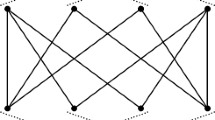Abstract
We present a moderately exponential time algorithm for the satisfiability of Boolean formulas over the full binary basis. For formulas of size at most cn, our algorithm runs in time \({2^{(1-\mu_{c})n}}\) for some constant μ c > 0. As a byproduct of the running time analysis of our algorithm, we obtain strong average-case hardness of affine extractors for linear-sized formulas over the full binary basis.
Similar content being viewed by others
References
Miklós Ajtai (1983) \({\Sigma^{1}_{1}}\) -formulae on finite structures. Ann. Pure Appl. Logic 24(1): 1–48
Andreev A.E. (1987) On a method for obtaining more than quadratic effective lower bounds for the complexity of π-schemes. Moscow Univ. Math. Bull. 42(1): 63–66
Vikraman Arvind & Rainer Schuler (2003). The Quantum Query Complexity of 0-1 Knapsack and Associated Claw Problems. In Proceedings of the 14th Annual International Symposium on Algorithm and Computation (ISAAC), 168–177.
Armin Biere, Marijn Heule, Hans van Maaren & Toby Walsh (editors) (2009). Handbook of Satisfiability, volume 185 of Frontiers in Artificial Intelligence and Applications. IOS Press.
Jean Bourgain (2007). On the construction of affine-source extractors. Geometric and Functional Analysis 17(1): 33–57
Chris Calabro, Russell Impagliazzo & Ramamohan Paturi (2006). A Duality between Clause Width and Clause Density for SAT. In Proceedings of the 21st Annual IEEE Conference Computational Complexity (CCC), 252–260.
Chris Calabro, Russell Impagliazzo & Ramamohan Paturi (2009). The Complexity of Satisfiability of Small Depth Circuits. In Proceedings of the 4th International Workshop on Parameterized and Exact Computation (IWPEC), 75–85.
Evgeny Dantsin & Edward A. Hirsch (2009). Worst-Case Upper Bounds. In Handbook of Satisfiability, volume 185 of Frontiers in Artificial Intelligence and Applications, 403–424. IOS Press.
Evgeny Dantsin, Edward A. Hirsch & Alexander Wolpert (2004). Algorithms for SAT Based on Search in Hamming Balls. In Proceedings of the 21st Annual Symposuim on Theoretical Aspects of Computer Science (STACS), 141–151.
Evgeny Dantsin, Edward A. Hirsch & Alexander Wolpert (2006). Clause Shortening Combined with Pruning Yields a New Upper Bound for Deterministic SAT Algorithms. In Proceedings of the 6th Conference on Algorithms and Complexity (CIAC), 60–68.
Merrick L. Furst, James B. Saxe & Michael Sipser (1984). Parity, Circuits, and the Polynomial-Time Hierarchy. Mathematical Systems Theory 17(1), 13–27
Johan Håstad (1986). Almost Optimal Lower Bounds for Small Depth Circuits. In Proceedings of the 18th Annual ACM Symposium on Theory of Computing (STOC), 6–20.
Johan Håstad (1998) The Shrinkage Exponent of de Morgan Formulas is 2. SIAM J. Comput. 27(1): 48–64
Timon Hertli (2011). 3-SAT Faster and Simpler - Unique-SAT Bounds for PPSZ Hold in General. In Proceedings of the 52nd Annual IEEE Symposium on Foundations of Computer Science (FOCS), 277–284.
Edward A. Hirsch (2008). Exact Algorithms for General CNF SAT. In Encyclopedia of Algorithms. Springer-Verlag.
Russell Impagliazzo, William Matthews & Ramamohan Paturi (2012). A satisfiability algorithm for AC0. In Proceedings of the 23rd Annual ACM-SIAM Symposium on Discrete Algorithms (SODA), 961–972.
Russell Impagliazzo, Noam Nisan (1993) The Effect of Random Restrictions on Formula Size. Random Struct. Algorithms 4(2): 121–134
Xin Li (2011). A New Approach to Affine Extractors and Dispersers. In Proceedings of the 26th Annual IEEE Conference on Computational Complexity (CCC), 137–147.
Chi-Jen Lu & Hsin-Lung Wu (2010). On the Hardness against Constant-Depth Linear-Size Circuits. In Proceedings of the 16th Annual International Computings and Combinatorics Conference (COCOON), 13–22.
Kazuhisa Makino, Suguru Tamaki & Masaki Yamamoto (2011). Derandomizing HSSW Algorithm for 3-SAT. In Proceedings of the 17th Annual International Computings and Combinatorics Conference (COCOON), 1–12.
Burkhard Monien, Ewald Speckenmeyer (1985) Solving satisfiability in less than 2n steps. Discrete Applied Mathematics 10: 287–295
Robin A. Moser & Dominik Scheder (2011). A Full Derandomization of Schöning’s k-SAT Algorithm. In Proceedings of the 43rd Annual ACM Symposium on Theory of Computing (STOC), 245–252.
Noam Nisan, Avi Wigderson (1994) Hardness vs Randomness. J. Comput. Syst. Sci. 49(2): 149–167
Ramamohan Paturi, Pavel Pudlák, Michael E. Saks, Francis Zane (2005) An improved exponential-time algorithm for k-SAT. J. ACM 52(3): 337–364
Ramamohan Paturi, Pavel Pudlák & Francis Zane (1999). Satisfiability Coding Lemma. Chicago J. Theor. Comput. Sci. 1999, 19 pages.
Pavel Pudlák (1998). Satisfiability - Algorithms and Logic. In Proceedings of the 23rd International Symposium on Mathematical Foundations of Computer Science (MFCS), 129–141.
Rahul Santhanam (2010). Fighting Perebor: New and Improved Algorithms for Formula and QBF Satisfiability. In Proceedings of the 51st International Symposium on Foundations of Computer Science (FOCS), 183–192.
Uwe Schöning (1999). A Probabilistic Algorithm for k-SAT and Constraint Satisfaction Problems. In Proceedings of the 40th Annual Symposium on Foundations of Computer Science (FOCS), 410–414.
Rainer Schuler (2005) An algorithm for the satisfiability problem of formulas in conjunctive normal form. J. Algorithms 54(1): 40–44
Subbotovskaya B.A. (1961) Realizations of linear functions by formulas using and, or, not. Soviet Mathematics Doklady 2: 110–112
Ryan Williams (2010). Improving exhaustive search implies superpolynomial lower bounds. In Proceedings of the 42nd Annual ACM Symposium on Theory of Computing (STOC), 231–240.
Ryan Williams (2011). Non-uniform ACC Circuit Lower Bounds. In Proceedings of the 26th Annual IEEE Conference on Computational Complexity (CCC), 115–125.
Andrew Chi-Chih Yao (1985). Separating the Polynomial-Time Hierarchy by Oracles (Preliminary Version). In Proceedings of the 26th International Symposium on Foundations of Computer Science (FOCS), 1–10.
Amir Yehudayoff (2011) Affine extractors over prime fields. Combinatorica 31(2): 245–256
Author information
Authors and Affiliations
Corresponding author
Rights and permissions
About this article
Cite this article
Seto, K., Tamaki, S. A satisfiability algorithm and average-case hardness for formulas over the full binary basis. comput. complex. 22, 245–274 (2013). https://doi.org/10.1007/s00037-013-0067-7
Received:
Published:
Issue Date:
DOI: https://doi.org/10.1007/s00037-013-0067-7




